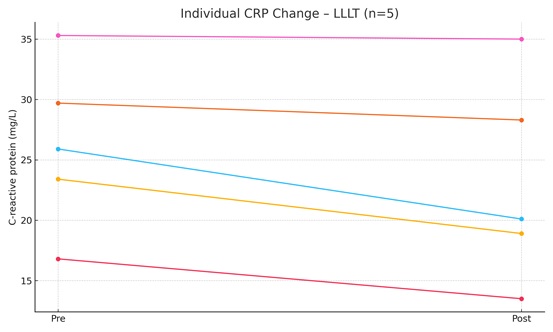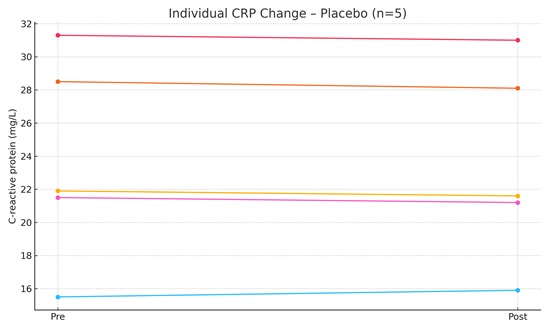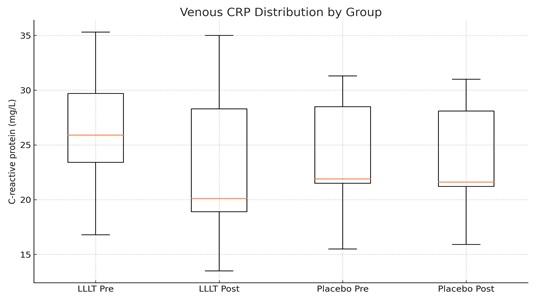
Systemic C-Reactive Protein Reduction Following Jugular-Applied Coherent Low-Level Laser Therapy
*Corresponding Author(s):
Travis SammonsClinical Affairs Manager, Erchonia Corporation, United States
Tel:+1 888-242-0571,
Email:tsammons@erchonia.com
Abstract
This study evaluated the anti-inflammatory effects of jugular-applied coherent low-level laser therapy (LLLT) in geriatric dogs with chronic arthritis. Ten Beagles were randomized to receive either a 20-minute session of coherent 640 nm red LLLT or placebo handling without laser emission. Serum C-reactive protein (CRP) was measured before and 24 hours after treatment. The LLLT group showed a significant reduction in CRP (−3.06 mg/L, p = 0.038), while the placebo group showed no significant change (−0.18 mg/L, p = 0.29). Between-group comparison approached significance (p = 0.074) with a large effect size (Cohen’s d = −1.80). These results suggest that coherent LLLT applied over the jugular vein may reduce systemic inflammation, offering a non-pharmacologic alternative to manage chronic inflammatory conditions.
Keywords
Anti-inflammation; Low-level laser therapy; C-reactive protein.
Introduction
C-reactive protein (CRP) is a highly sensitive acute-phase reactant and established biomarker of systemic inflammation. Elevated CRP is associated with a wide range of inflammatory and degenerative conditions in both human and veterinary medicine [1]. In canine arthritis, persistent inflammation contributes to joint degeneration, pain, and impaired mobility.
Low-level laser therapy (LLLT) has demonstrated anti-inflammatory and analgesic effects in both preclinical and clinical models [2]. However, the systemic impact of jugular-applied LLLT on circulating CRP levels—particularly using a coherent light configuration over the jugular—has not been previously studied. This study investigates the effect of a single jugular LLLT session on venous CRP concentration 24 hours post-treatment, using a placebo-controlled design in aged Beagles with chronic arthritic symptoms.
Materials and Methods
Procedures were performed at the National Center for Laboratory Animal Production (CENPALAB). Ten geriatric Beagle dogs (mean age: 11.6 years) diagnosed with chronic arthritis were enrolled and randomly assigned to two groups. The first group (n = 5) received active 640 nm red coherent laser therapy (Erchonia Corp.) applied over the jugular vein for a duration of 20 minutes. The second group (n = 5) served as a placebo control and underwent identical handling without laser emission. Venous blood samples were collected from the jugular vein at baseline (Pre) and again 24 hours post-intervention (Post). Serum C-reactive protein (CRP) concentrations were measured using a validated, canine-specific high-sensitivity immunoturbidimetric assay.
Statistical Analysis
Paired Student t-tests were conducted for Pre vs Post within each group. Between-group comparison of the difference (Δ = Post − Pre) employed the Mann–Whitney U test. Effect size was estimated with Cohen d (d = -1.80). Significance threshold: α = 0.05 (Figures 1-3 & Table 1).
Results
|
Group |
n |
Mean Pre |
SD Pre |
Mean Post |
SD Post |
Mean Δ |
SD Δ |
p Pre vs Post |
|
LLLT |
5.00 |
26.22 |
6.92 |
23.16 |
8.48 |
-3.06 |
2.24 |
0.04 |
|
Placebo |
5.00 |
23.74 |
6.25 |
23.56 |
6.00 |
-0.18 |
0.33 |
0.29 |
Table 1. Changes in Serum C-Reactive Protein (CRP) Pre- and 24 Hours Post-Intervention in LLLT and Placebo Groups
Between - group test on Δ: Mann–Whitney U test = 3.50, p = 0.074. Average CRP reduction in LLLT: -3.06 mg/L; in placebo: -0.18 mg/L.
 Figure 1. Individual CRP change – LLLT
Figure 1. Individual CRP change – LLLT
 Figure 2. Individual CRP change – Placebo
Figure 2. Individual CRP change – Placebo

Figure 3. Venous CRP distribution by group (Pre vs Post).
Discussion
C-reactive protein (CRP) is a key acute-phase reactant and a central biomarker of systemic inflammation in both veterinary and human medicine. Synthesized by hepatocytes in response to pro-inflammatory cytokines—particularly interleukin-6 (IL-6)—elevated CRP is not only a signal of inflammation but also a pathogenic contributor to disease progression [3]. Persistent elevations in CRP are closely associated with a range of chronic conditions, including osteoarthritis, cardiovascular disease, renal dysfunction, diabetes, and neurodegenerative disorders. In dogs with chronic arthritis, as studied here, elevated CRP reflects an ongoing systemic inflammatory state that extends beyond localized joint pathology. This low-grade, chronic inflammation places metabolic strain on multiple organ systems, promoting oxidative stress, endothelial dysfunction, and immune dysregulation [4]. Reducing CRP is therefore not merely a marker of improved inflammation but may have direct therapeutic relevance in limiting progression of age-related comorbidities.
Pharmacologic interventions—particularly non-steroidal anti-inflammatory drugs (NSAIDs)—are commonly used to manage arthritis and systemic inflammation. However, chronic NSAID administration is associated with gastrointestinal ulceration, renal compromise, and hepatotoxicity, especially in geriatric populations with reduced organ reserve [5]. These safety concerns underscore the need for non-pharmacologic, organ-sparing alternatives capable of modulating inflammatory pathways.
The current findings support jugular-applied coherent low-level laser therapy (LLLT) as a promising adjunct or alternative strategy. A single session of LLLT produced a statistically significant reduction in serum CRP (−3.06 mg/L), while placebo handling had no meaningful effect. Though the between-group comparison approached but did not reach significance (p = 0.074), the large effect size (Cohen’s d = −1.80) suggests a biologically relevant response. The mechanism by which jugular LLLT reduces CRP likely involves systemic modulation effects, including mitochondrial activation and enhanced redox balance, downregulation of pro-inflammatory cytokines such as IL-6 and TNF-α, and stabilization of endothelial and immune cell function. Importantly, the jugular vein is a high-flow vascular structure, allowing coherent laser energy to interact with circulating photoacceptors such as hemoproteins. This delivery method may bypass the limitations of traditional site-specific LLLT and instead entrain a global immunomodulatory effect.
Conclusion
These preliminary results support LLLT as a non-invasive, repeatable, and drug-free modality for managing systemic inflammation in aging or chronically ill dogs. Reducing CRP through such interventions may improve resilience, delay disease progression, and decrease reliance on long-term pharmacotherapy. Further research is warranted to determine the optimal treatment frequency and duration required to maintain or further reduce CRP levels.
References
- Luan YY, Yao YM (2018) The clinical significance and potential role of C-reactive protein in chronic inflammatory and neurodegenerative diseases. Frontiers in immunology 9: 1302.
- Wickenheisser VA, Zywot EM, Rabjohns EM, Lee HH, Lawrence DS, et al. (2019) Laser light therapy in inflammatory, musculoskeletal, and autoimmune disease. Current allergy and asthma reports 19: 37.
- Rizo-Téllez SA, Sekheri M, Filep JG (2023) C-reactive protein: a target for therapy to reduce inflammation. Frontiers in immunology 14: 1237729.
- Mouliou DS (2023) C-reactive protein: pathophysiology, diagnosis, false test results and a novel diagnostic algorithm for clinicians. Diseases 11: 132.
- Bindu S, Mazumder S, Bandyopadhyay U (2020) Non-steroidal anti-inflammatory drugs (NSAIDs) and organ damage: A current perspective. Biochemical pharmacology 180: 114147.
Citation: Sammons T, Huff D, Teste IS (2025) Systemic C-Reactive Protein Reduction Following Jugular-Applied Coherent Low-Level Laser Therapy. J Anim Res Vet Sci 9: 067.
Copyright: © 2025 Travis Sammons, et al. This is an open-access article distributed under the terms of the Creative Commons Attribution License, which permits unrestricted use, distribution, and reproduction in any medium, provided the original author and source are credited.

